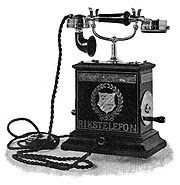This history of mobile phones chronicles the development of radio telephone technology from two-way radios in vehicles to handheld cellular communicating devices.
In the beginning, two-way radios (known as mobile rigs) were used in vehicles such as taxicabs, police cruisers, ambulances, and the like, but were not mobile phones because they were not normally connected to the telephone network. Users could not dial phone numbers from their vehicles. A large community of mobile radio users, known as the mobileers, popularized the technology that would eventually give way to the mobile phone. Originally, mobile phones were permanently installed in vehicles, but later versions such as the so-called transportables or "bag phones" were equipped with a cigarette lighter plug so that they could also be carried, and thus could be used as either mobile or as portable two-way radios. During the early 1940s, Motorola developed a backpacked two-way radio, the Walkie-Talkie and later developed a large hand-held two-way radio for the US military. This battery powered "Handie-Talkie" (HT) was about the size of a man's forearm.
In Europe, radio telephony was first used on the first-class passenger trains between Berlin and Hamburg in 1926. At the same time, radio telephony was introduced on passenger airplanes for air traffic security. Later radio telephony was introduced on a large scale in German tanks during the Second World War. After the war German police in the British zone of occupation first used disused tank telephony equipment to run the first radio patrol cars.[citation needed] In all of these cases the service was confined to specialists that were trained to use the equipment. In the early 1950s ships on the Rhine were among the first to use radio telephony with an untrained end customer as a user.
Subscribe to:
Post Comments (Atom)

No comments:
Post a Comment